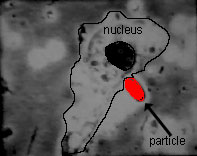Macrophages (histiocytes) - are phagocytes - these cells 'eat' particles such as bacteria.
These cells are derived from white blood cells called monocytes (see the section on blood).
Macrophages (histiocytes) - are phagocytes - these cells 'eat' particles such as bacteria.
These cells are derived from white blood cells called monocytes (see the section on blood).

Here is a movie of a macrophage phagocytosing.
The image on the right is the first frame of the movie showing the outline of the macrophage, and the particle it is going to phagocytose (in red).
Mast Cells are found close to small blood vessels in loose connective tissue. They contain large secretory granules of heparin proteoglycan - a weak anticoagulant. They also contain histamine, which promotes an inflammatory reaction when secreted. Release of histamine causes endothelial cells lining venules to contract, weakening the junctions between these cells, and allowing proteins and cells from the plasma to leak through into the connective tissue.
These cell play a key role in allergic reactions.
Histamine also causes constriction of the bronchioles, and vasodilatation.
Plasma Cells are derived from white blood cells called B-cells, and are more usually found in lymph nodes They are important in developing immunity.